Smart on Crime Blog
Posted on: August 3rd, 2012 by Smart on Crime
Guest blog post from Fanis Juma Radstake
In response to the July Toronto shootings, it was reported that the Toronto Police Chief, the Ontario Premier and the Toronto Mayor held a meeting that resulted in a decision to continue to fund an increased police presence in Toronto neighbourhoods that are affected by youth violence. This will be done by securing ongoing funding for the Toronto Anti-Violence Intervention Strategy (TAVIS). In March of 2012, it was reported in the Toronto Star that TAVIS, a program created by Toronto Police Chief Blair, operates by “targeting violent areas with officers who stop, question and document at a higher rate than regular officers”. The same report also revealed that “in each of the city’s 72 patrol zones, blacks are more likely than whites to be stopped and carded. The likelihood increases in areas that are predominantly white”. TAVIS will continue to receive $5 million per year for the deployment of police into the poor Toronto neighbourhoods affected by crime. While reading these reports, I can’t help but question what fraction of those dollars could be effective in providing mental health support, educational support or youth employment opportunities in urban immigrant communities. It still leaves me with a questions that lingers: Who says that what our beautiful children need is more police?
As an African immigrant mother with a young black son and community organizer working with the African Canadian Association of Waterloo Region and Area, I am concerned about the disproportionate rate of African youth incarceration that we are experiencing in our community and in neighbouring Ontario urban immigrant communities. In rural Ontario and in white suburban neighborhoods a youth is far less likely to become system involved than a visible minority youth in the city even if they commit the same crime. We know that teenagers who become involved in the correction system at an early age instead of receiving education and employment supports, addictions and/or mental health services and other tangible opportunities for success are more likely to commit a violent crime in the future. We also know that children and youth in low-income urban communities where most of our African immigrant communities reside are less likely to have access to the same educational opportunities and social supports as youth living in middle-income suburbs, and rural communities. As community leaders we are able recognize that our elected officials and public servants have weighty responsibilities while responding to incidences of youth violence in affected neighbourhoods. But we do want to see a balanced approach that recognizes the value of investing in protective factors that increase chances of wellness and success for ALL youth.
We need to support existing community-led early intervention programming that work; homework support programs, green collar summer jobs for youth, cultural-based community and family services and neighbourhood based youth centres. These efforts are often self-led by affected urban immigrant communities who are trying to support their children and youth. The Somali community is working so hard in Toronto with very little resources to engage their youth after school. The same kind of community-led efforts are being made in other Ontario urban centers including the Waterloo Region. Some of these programs can serve up to 100+ children on a school evening and run on as little as $5,000 to $10,000 dollars per year per site. Also in the Waterloo Region, the African Community Wellness Initiative has worked with community partners and on minimal resources to develop four community garden sites with the intent of creating employment opportunities for our youth.
No child is born with a propensity to commit crime. Research has shown that “the positive growth and adaptation of newcomer youth are dependent on the personal, social, and economic resources available to the individual, as well as to his or her family and community” (To Build Hope: Overcoming the Challenges Facing Newcomer Youth At-Risk in Ontario, Kilbride & Anisef, 2001). I believe that we need to invest more intentionally in the personal, social and economic well-being of young people to prevent youth crime and violence. Parents and cultural leaders from affected communities take seriously the needs of our families and youth and we are working hard to re-create the supportive networks that are interrupted during the settlement process. As community leaders, we are not asking or waiting for handouts, we seek and develop our own solutions for the protection and safety of our youth; and we almost always do so with very minimal resources. As June Jordan wrote in her 1956 Poem to South African Women; “we are the ones we’ve been waiting for”!
This is a mobilizing call for the voices of Ontario mothers of immigrant youth from affected communities; we need to rally in support for wellness promoting community efforts and the protection of our youth. We also call on our allies from all sectors to join in the conversation and gain an understanding of the proven alternative approaches to preventing youth violence in our cities. If this concerns you and you want more information on how to join, support or start a local mobilization for the protection of immigrant youth in your Ontario city, connect with us.
Fanis Juma Radstake is an African born immigrant and mother living in the Waterloo Region. She is also a community organizer with the African Community Wellness Initiative that seeks to increase immigrant participation in promoting community wellness. Currently Fanis is involved in promoting urban agriculture opportunities for immigrant youth in the Waterloo Region through Young City Growers. Fanis can be contacted via the African Canadian Association of Waterloo Region.
This article reflects the writer’s own opinions and do not necessarily reflect the views or official positions of the Waterloo Region Crime Prevention Council.
Posted on: July 25th, 2012 by Waterloo Region Crime Prevention Council
For those interested in crime prevention the last couple weeks have certainly given many reasons for reflection. The recent shootings in Toronto at a neighbourhood party resulting in 2 deaths, the shootings at the Eaton Centre and those that are reported regularly in the press certainly make one think that violence and crime rates are on the rise. However, the release of the most recent crime statistics from Stats Canada show a decrease in the overall volume of crime, a decline of 6%, following a steady decrease over time. Sadly, there are increases in homicides (7%), a rise in sexual offences against children (3%) and a sharp rise in child pornography (40%), likely helped along by the ease of technology to traffic in illegal images. Still, the overall decline in crime rates has areas of concern that need be addressed. Organizations at all levels of government as well as several of those unrelated to government work each day to alleviate the common root causes of crime. Acts of unexplainable violence, heavily reported in the media cause fear and apprehension, if not confusion, for the public.
Unfortunately, into the mix come politicians like Mayor Rob Ford of Toronto who mused in a radio call in show about using immigration laws to keep criminals out of Toronto and to send them who knows where. He didn’t specify a location. I think he may have watched one too many John Wayne westerns where gun slingers were told to get out of town (no slight to the memory of the Duke intended). Aside from displaying a woeful lack of knowledge about the laws of Canada, he also seems to have a limited understanding of the powers of his office. Thank goodness our municipal leaders had the insight to create and support the Waterloo Region Crime Prevention Council several years ago. This body, made up of representatives from local government, the police, social agencies, community reps and volunteers, provides advice and input into policies related to social development issues regarding crime prevention in Waterloo Region. Maybe that’s something Mayor Ford might consider adopting. Instead, he rails at what he derisively terms “hug a thug” programs that deter youth from crime. Are the programs completely successful? Absolutely not. Are they helping many young people, fathers, mothers and agencies live a more productive life? You bet. Much has been written in the news media critical of Mayor Ford’s linking the recent shootings to immigration and his demand for more police for Toronto, “Money Talks, BS Walks”. This bullying bravado is hardly a model of reasoned leadership. It makes a great headline but governing responsibly is beyond headlines and captions. It’s actually hard work.
Then we have Public Safety Minister Vic Toews trumpeting his government’s crime agenda but noting that crime has significantly increased since 1962.

You may remember 1962. Many of you probably weren’t yet born. I was 10 years old. My favourite show that year was McHale’s Navy. I could buy a chocolate bar for 5 cents, I delivered the Pink Tely (Toronto Telegram) which scared me with headlines about the Cuban Missile Crisis, John Diefenbaker was the Prime Minister. Jann Arden was born that year. My parents bought their first house for $15,000. Great year…relevant to the debate? Perhaps, but I don’t see the connection. Many things have changed. For example, the criminal code has changed, laws have changed. The way crime statistics are reported and tracked has changed. And we didn’t have the Internet back then so electronic file sharing of child porn was impossible, it was just a very different time so to draw a comparison in regards to crime rates doesn’t seem to contribute to the debate. One of my favourite movies is “Back to the Future” but, fun as it was, even Marty McFly chose not to stay in the past.
Just this past week the horrific killings in Colorado give us further reason to reflect upon the scourge of violence in our society. There are fierce debates about gun control and the role of violence in the media as contributing factors in this tragedy. The victims all led productive lives up to this point and even the alleged perpetrator doesn’t necessarily fit our preconceived notion of a mass killer: loner, poverty-stricken, poor family attachment, uneducated and so on. It’s early days yet so we don’t know (and won’t for some time) what caused this person to take the actions he is alleged to have committed. What is certain is that there are no easy answers when it comes to crime and its prevention.
There are no “silver bullets”, just ugly copper ones that rip the hearts from people and communities. We can’t allow ourselves the luxury of trying to find the one answer, the quick fix. We can’t expect fully-funded social programs nor increased police budgets to be the one answer. It’s more of a “both and” than an “either or” approach. We can’t blame immigrants, colour, religion, economic status, educational levels or any one thing. Crime is a complex issue and its prevention therefore is equally complex. Rather than react to situations on an emotional level (which is completely understandable for victims and their families) and calling for tougher approaches to crime, as a society it’s important to look at the data provided in the most recent StatsCan report and target our interventions on closing the most obvious gaps. Working with community partners, the Waterloo Region Crime Prevention Council acts as a advocate for responsible policies, programs and legislation in order to help our Region be a safer place to live. The answer is not only with the government, the police or social agencies. It is the collective responsibility of each of us to do our part to build a community less likely to be violent and reactive.
Author: Frank Johnson is a regular guest writer for Smart on Crime in Waterloo Region. Frank is a retired principal with the local Catholic school board, a dad, and sometimes runner who possesses an irreverent sense of humour that periodically gets him in trouble. He lives in Waterloo, Ontario.
Frank Johnson’s writing reflects his own opinions and do not necessarily reflect the views or official positions of the Waterloo Region Crime Prevention Council.
Posted on: June 28th, 2012 by Smart on Crime
A colleague passed along this ‘advice from a tree’ image to me last week.

Source: yourtrunature.com
It made me wonder… what advice would our Smart on Crime tree give?
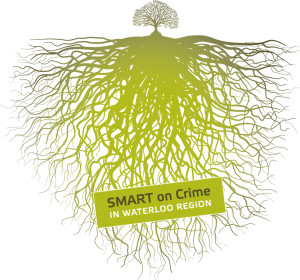
Use the comment section below to let us know what advice you think our Smart on Crime tree would give.
Posted on: June 15th, 2012 by Smart on Crime
Walking into the prison for the first time was an experience I won’t soon forget. Heavy doors locked behind me one after the other. I got this strange feeling that there was no way out. I didn’t share the same fear as my family, who worried about my safety. And I didn’t really feel intimidated by the guards. What I did feel was worry – worry that the women inside would judge me for what I am – a (prissy) master of social work student.
I’m not talking about going to prison because of a crime I committed, I’m talking about being a participant of the Inside Out Prison Exchange Program and a member of the Walls to Bridges Collective.
|
From the founder & director of Inside-Out, here’s what the program is NOT:
It is not research. Outside students are not going in to study inside students. Outside students are also not going inside to “help” the inside students. “That’s just not what we’re doing. We are learning together”. “
– Lori Pompa
|
Basically the program looks like this: people in university (“outside students”) and people in custody (“inside students”), come together to take a course behind the walls of a correctional institution. The course can be anything from literature and history, to social work and criminology. So although the course content is usually pretty standard, the classroom and the students are anything but.
The purpose of Inside-Out (I-O) is to increase educational opportunities for people inside and outside of prison. In an I-O class, we emphasize dialogue and collaboration, and talk about social concern issues. We break down the walls that separate us.
Experiencing Inside-Out is often referred to as personally and professionally “transformative”. But what is it about the program that makes it so?
From my experience, it’s got a lot to do with recognizing and challenging assumptions and biases. It’s got a lot to do with questioning society and the powerful impact of oppression and privilege. It’s got a lot to do with building relationships and honoring individual lived experiences.
During our closing ceremony for the first Inside-Out course in Grand Valley Institution for Women, one of my colleagues articulated the transformation she saw and experienced:
“Pre-conceived notions. We are all guilty of harboring them. Notions of what we think things are supposed to be. Things like prison, and education. Of what and who the student is, and what and who the convict is… Today those lines are blurred. No, today they don’t exist. Today there is no distinction between student and convict and education and prison… because today, right here, we are all students. Learning. Evolving. Erasing. Celebrating”
– Inside-Out Alumni, currently incarcerated
The Inside-Out alumni group now meets bi-weekly to work on projects inside and outside of the prison walls. The “Walls to Bridges Collective” exemplifies “smart on crime” in action:
Through collaboration with people living inside and outside prison walls, we will strive to connect and build bridges by educating, informing and advocating about social justice for criminalized women and trans people.
As a passionate and engaged community, we’re being smart on crime together…. and, this is only the beginning.
To read the “Inside-Out Center Newsletter”, where the Walls to Bridges Collective is featured, click here.
Today the Inside-Out Program exists in 25 American states and growing fast. In September 2010, the Lyle S. Hallman Faculty of Social Work at Wilfrid Laurier University, and Grand Valley Institution for Women partnered to host this ground-breaking program, being one of the first ever Canadian Inside-Out Programs. The second WLU & GVI course just finished in April 2012 and two more will be starting in September 2012. We have also begun developing an Inside-Out Canadian Instructor Training Institute where all Canadian instructors interested in teaching Inside-Out courses will come to get trained in the Inside-Out pedagogy.
Author: Kayla Follet – Born in St. John’s, Newfoundland, Kayla studied at St. Thomas University in Fredericton, New Brunswick where she completed an honours degree in Criminology and Criminal Justice. Upon graduation she travelled and worked in different community settings. She is now working toward her Master of Social Work degree from Wilfrid Laurier University and happily fulfilling her Practicum Placement at the Waterloo Region Crime Prevention Council.
Posted on: May 31st, 2012 by Waterloo Region Crime Prevention Council
This week, I joined KidsLINK and community leaders from across Waterloo Region and the child and youth services sector in Ontario to talk about trauma – really, a conversation of hope and change, challenge and change…. and of course, prevention.
This was my first experience hearing from Dr. Ann Jennings – an advocate for changing our social and human service systems to be equipped to deal with early childhood trauma. Dr. Jennings used the 15 year Adverse Childhood Experiences study to outline the impacts of childhood trauma and the long term consequences of unaddressed trauma. The parallels to “root causes” of crime and “risk factors” for crime that informs the work of the Waterlo Region Crime Prevention Council were not lost on me! I felt like Dr. Jennings was speaking our language!!
What spoke volumes was Dr. Jennings’ story of her daughter Anna.
“Anna Jennings was sexually abused when she was less than three years old. This was the first of several abuses that occurred over her lifetime, and put a confused, frightened child into a mental health system that neither recognized nor treated Anna’s real problem. Diagnosed “schizophrenic”.. she was institutionalized for more than 12 years from age 15 to 32. Although she attempted to communicate the “awful things” that had happened to her, there was no one to listen, understand or help her. She took her life on October 24, 1992, on a back ward of a state mental hospital.”
(http://www.theannainstitute.org/a-bio.html)
Dr. Jennings went on to outline the “wall of missed opportunities” that took place over the course of Anna’s life. The sheer number of dates, warning signs and professional involvements could have literally filled a wall. Had these opportunities not been missed, her daughter might have been helped and might still be alive today.
Why is it that we can pinpoint – after the fact – all the places in a person’s life where change could have made a difference, yet our services, systems, families, schools and communities can’t seem break through at those critical moments?
This got me wondering – what if our entire social support systems was equipped to recognize and deal with trauma in our children and youth. Dr. Jennings, quoting a colleague, suggested that if we could effectively do that, we could reduce the size of the Diagnostic and Statistical Manual of Mental Disorders (DSM-V) to that of a pamphlet. I suspect there might also be fewer people in the criminal justice system and in prison.
Research tells us that a high percentage of people in prisons, those with addictions and many who have mental health issues have stories of trauma such as abuse, witness to abuse, neglect, and early trauma in a household environment. Now, I’ve never been to prison, but I’ve visited enough of them to know that it is not a place where one could not effectively deal with the impact of trauma in a helpful way. Trauma-informed practices are showing evidence that another way is not only possible, but also practical and cost effective.
Through the ACE Study, it is estimated that the long term consequences of unaddressed trauma (disease, disability, suicide, chronic health problems and social problems) currently stands at $103,754,017,492.00. Yes, you read that correctly. That’s over 103 BILLION (US) dollars.
Now there’s a ” wall of missed opportunity”. Taking a prevention-based approach could save billions of dollars and help people in a healthier way.
Smart on crime, indeed.
Posted on: May 7th, 2012 by Waterloo Region Crime Prevention Council
The first weekend in May has quickly become known as Jane’s Walk weekend. That’s when thousands of people from neighbourhoods around the world join up with friends to take in free guided walks offered in their town or city. People get a chance to learn something new, discover a new part of their city, meet new (or existing!) neighbours and get in touch with the environment. Jane’s Walk helps neighbours and residents feel more connected to their community. WRCPC believes that a more connected community is a safer community. That’s why we got out and walked and encouraged the whole city to walk with us!
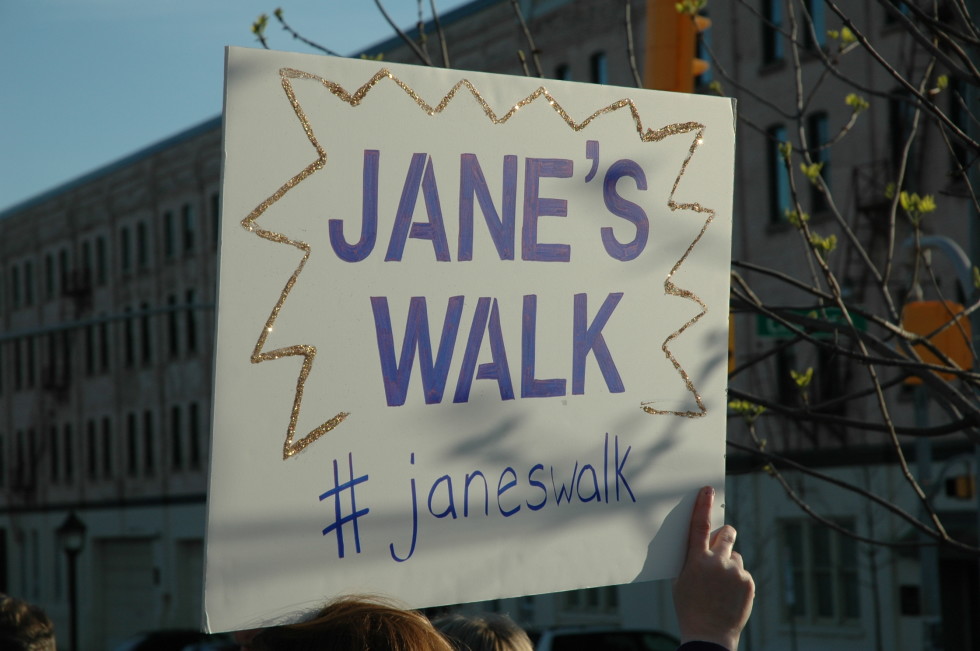
Jane’s Walk is in honour of Jane Jacobs, an urbanist and activist whose ideas came to prominence in New York in the early 1960’s. Her observations and writing were in response to city building that focused on car-centric development that effectively cut people off from each other, their neighbourhoods and their sense of place. Jane Jacobs believed that vibrant, dynamic, healthy and safe places need a sense of connection and that local residents must be involved in their own neighbourhood and city development. Jane Jacobs’ ideas of the city as an ecosystem have influenced generation of planner, architects, politicians, activists and citizens, just like you and me.
Jane Jacobs believed in connection to place – connection and knowing a place intimately cannot be done by looking at models and inventing dream cities, rather, Jane would say, “You’ve got to get out and walk!” She would say you’ve got to get to know you place – get to know it’s history, what and who has shaped it, how it is changing, what works well, what doesn’t work… who lives there and what might be its potential for the future. And that’s exactly what we did on our Jane’s Walk on May 5th. We brought together neighbours and residents to explore, discuss, ponder about possibilities and test out new perspectives.
The theme of our Jane’s Walk this year, lead by the Safe and Healthy Advisory Community Advisory Committee of Kitchener and the Waterloo Region Crime Prevention Council, focused on what makes a neighbourhood or street feel vibrant, dynamic, safe and healthy. We used the ‘Power of 10‘ – a concept developed by the Project for Public Spaces (PPS) to shape our walk. The Power of 10 is the ideas that every city or town has 10 identifiable destinations/districts. Each district has 10 places within it and each place has 10 things to do around it. When a place does this successfully, ten or more things or activities create an energy that is easily felt and identifiable.
Ten things might include places to sit, food, snacks and beverages, history to experience, music to hear, a playground to enjoy, art to touch or experience, people to meet, information to read, a green space or natural feature and walking/cycling trails or access to public transit.
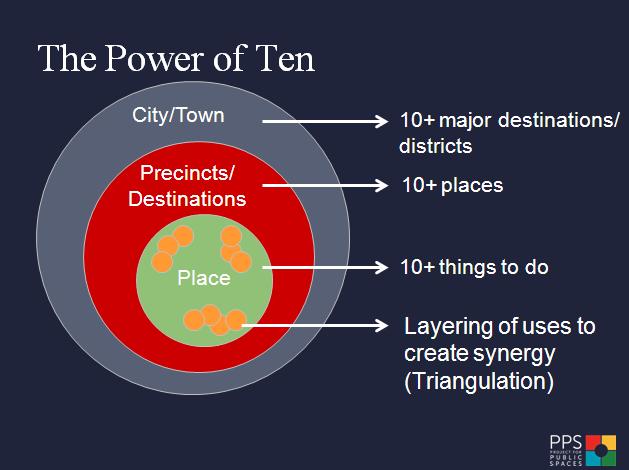
http://www.pps.org/reference/the-power-of-10/
During our walk of Downtown Kitchener, we examined 4 places that are identified & promoted as major places within the downtown district. We visited The Tannery (in the newly named Innovation District), Victoria Park, Market Lane & the Kitchener Market area, and the Centre in the Square. Each location prompted a lively interaction about its merits and what might improve the dynamics and vibrancy of some places that seemed to be lacking.
You might be wondering what this has to do with “smart on crime” or “crime prevention” or “safety”. Both PPS and Jane Jacobs would agree that the way a physical space is designed, promoted, maintained and managed has an impact – positive or negative – on the type of activity that happens in a place. Places that have a multi-purpose usage at varying times of the day and night and includes and engages a diversity of people, tend to be more vibrant, dynamic, safe and healthy place. Essentially, if we can reduce the likelihood of crime occurring and reduce the fear of crime through physical design and increased dynamic activity, that’s a pretty smart approach to crime prevention.
The four places we visited got mixed reviews on their success as a ‘great place’ with 10 or more things to do around them. Although, Victoria Park was clearly a ‘great place’ where people could easily identify 10 activities in close proximity. I invite you to go visit the four places and decide for yourself! Let us know what you think.
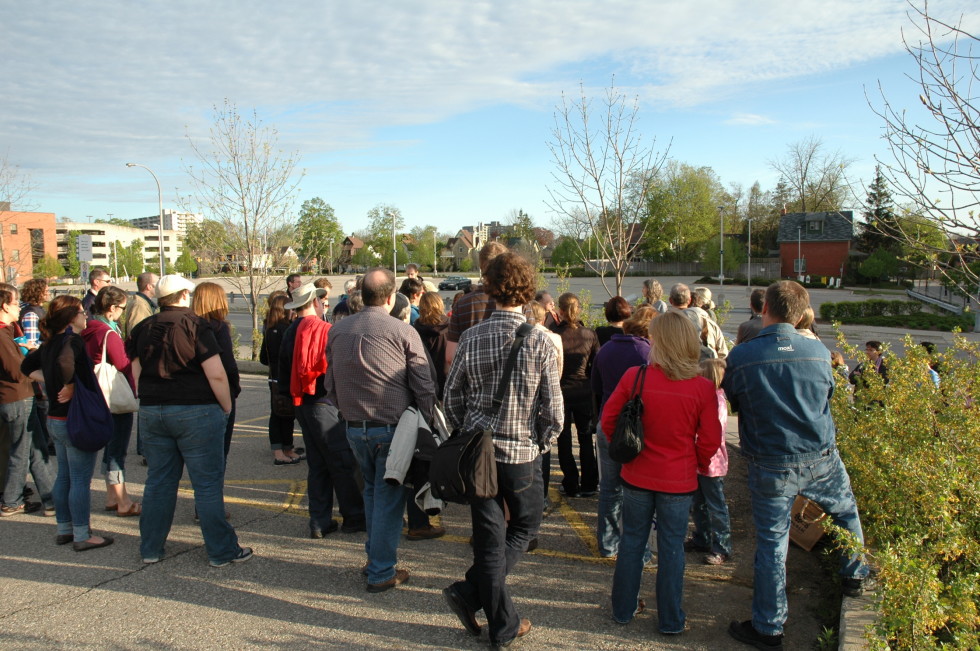
A crowd gatherings at The Tannery in the spring evening sun.
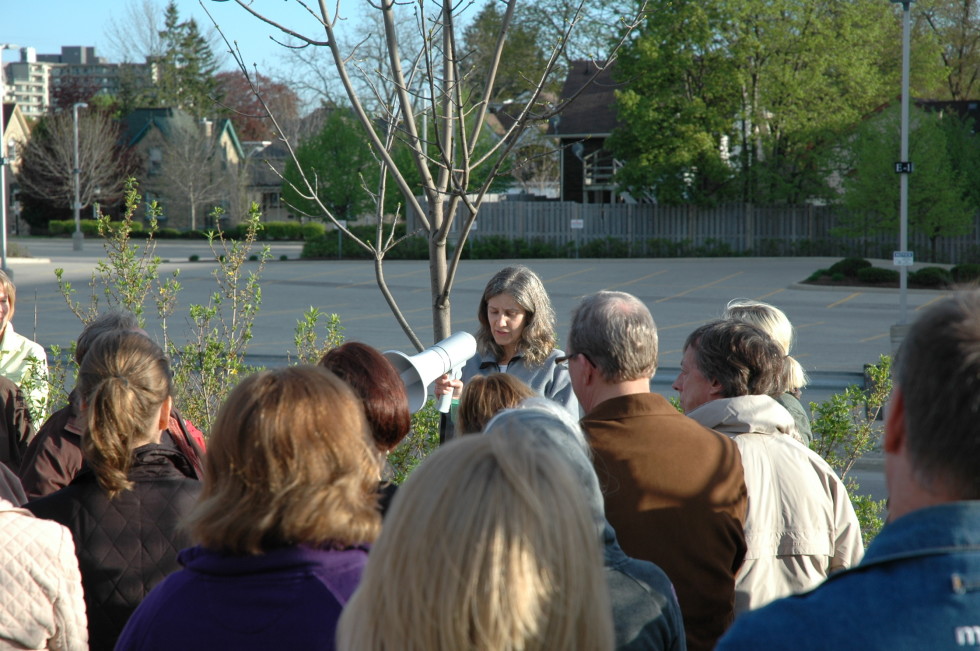
Juanita Metzger sets the stage for the “Community to the Power of 10” Jane’s Walk.
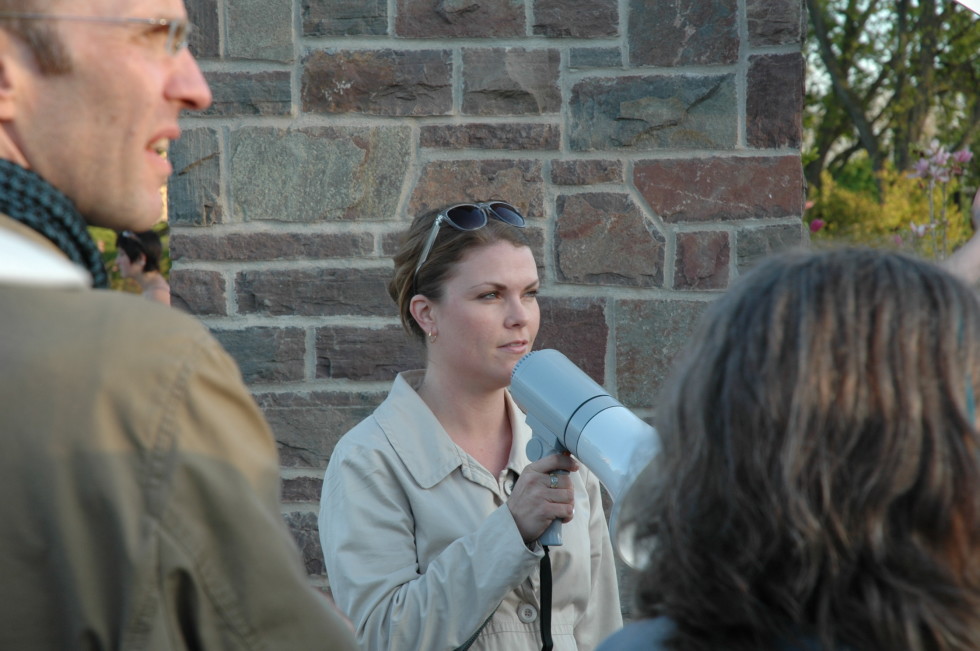
K. Jennifer Bedford talks about Victoria Park from the perspective of someone who lives in the neighbourhood.
What you can’t see in this photo is the scene that played out, over Jennifer’s shoulder, behind the pillar. A group of 10 – 12 youth where in the middle of an escalating argument. It seemed certain that someone was about to be hurt. Somehow, the presence of 70 people, suddenly looking on seemed to diffuse the situation. Jennifer responded to the situation beautifully – who wouldn’t take notice when a megaphone projected voice suddenly competes (and wins) over the shouting argument!
Never a dull moment on our walks!

Bill Rieck also talks about Victoria Park from the perspective of someone who lives in the neighbourhood.

Mark Garner, Executive Director, Kitchener Downtown Business Improvement Association gives a history and tour of Market Lane & the Market area of Downtown Kitchener.
 Friends take a break on the wall entrance to Victoria Park.
Friends take a break on the wall entrance to Victoria Park.

A crowd of 70 people stretches out over a whole block!! But it was always easy to follow the signs.
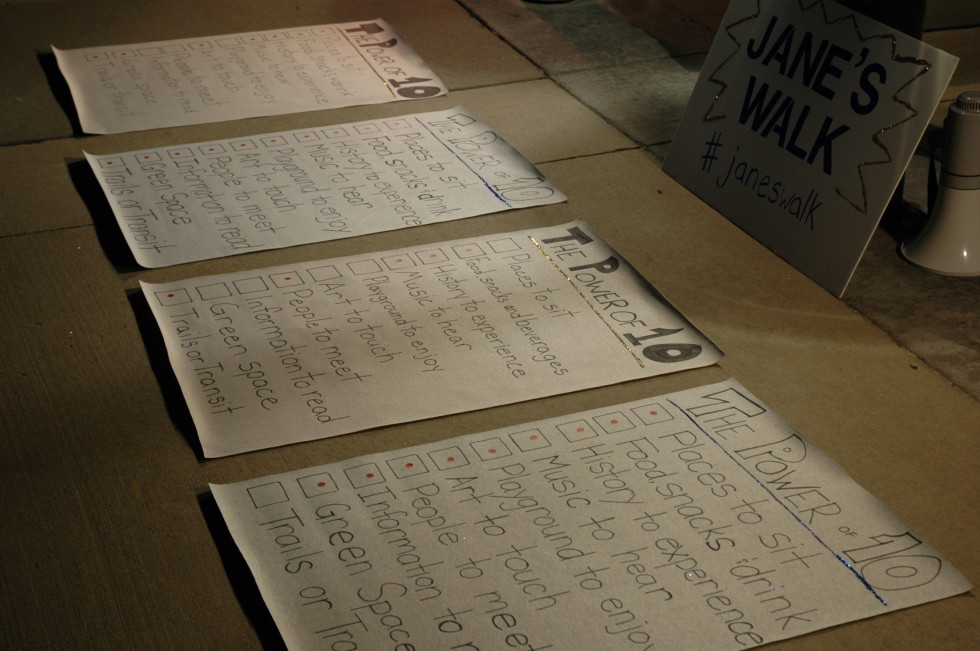
The crowd gets to compare the four places we visited on our Jane’s Walk.
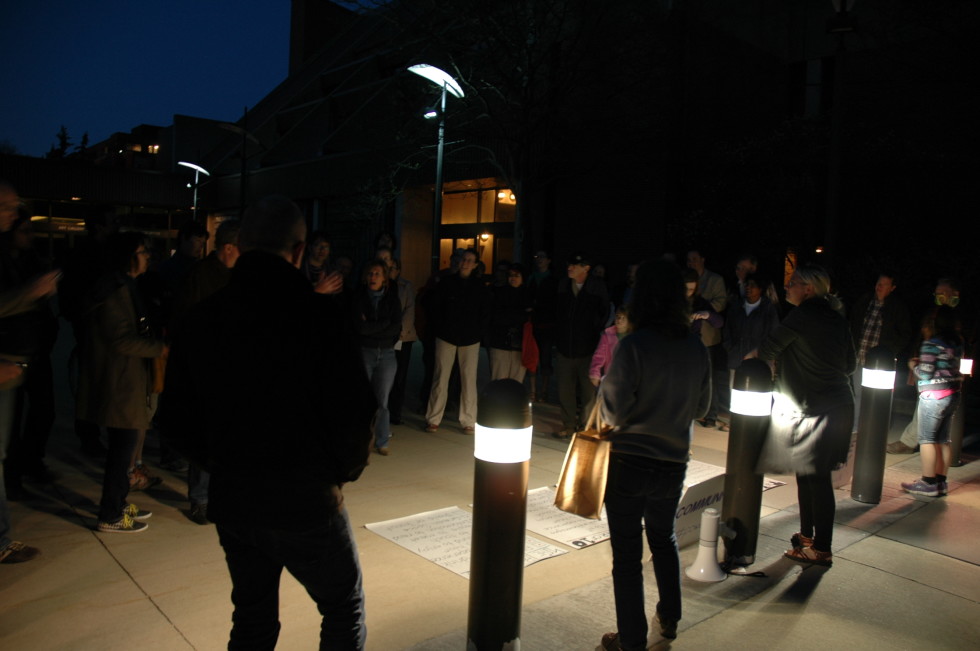
We finished up our Jane’s Walk at the Centre in the Square.
This Jane’s Walk had some real magical moments. Many people felt they had looked at very familiar places with a new perspective. With such a simple tool like “The Power of 10”, many people felt they could easily use the concept to examine and talk about their own street or neighbourhood in a new way.
But the most magical moment came at the end of the walk. As people drifted away in to the night, under the rising super moon, Elif Günçe, a recent immigrant to Canada and Kitchener and a woman I’ve met online and at various community meetings came to tell me how much she enjoyed the walk. Elif and her fiancée, who was visiting from Turkey, decided to come on the walk in order to explore their potential new home community. In fact, Elif and her fiancée were so impressed by the energy, enthusiasm and engagement of the walk participants that they decided, then and there, they would make Kitchener their new home when her fiancée returned to Canada permanently. That’s the power of community in action! Powerful enough that two people would be so inspired by citizen and resident passion for building a vibrant, dynamic, safe and healthy community that they would make it their new home.
Beautiful.
When you get the chance to take a Jane’s Walk next year, take it. You just never know what might happen.
Posted on: April 30th, 2012 by Waterloo Region Crime Prevention Council
And while we’re at it, let’s also talk about prevention, addictions and compassion.
I suppose you’re wondering, where am I going with all of this? Well, the Waterloo Region Crime Prevention Council recently held the 34th Annual Justice Dinner, an awareness-raising event about local justice issues. Our guest was The Honourable Justice Kofi Barnes, who started the very first Drug Treatment Court in 1998 in Toronto.
I was expecting a chronology and history about the initiation and implementation of the first Drug Treatment Court. However, I found myself leaning in a bit closer when Justice Barnes told his own personal story – how he was handed the task of finding alternative ways of dealing with the revolving door of people in courts and corrections who clearly had underlying addictions or mental health issues. Admittedly, fueled, in part, by a desire to preserve his career, and in part inspired by his own father, Justice Barnes spent 4 years developing an alternative ‘problem solving court’ which, 14 years later, has grown to more than 10 drug treatment and mental health courts in Canada.
What struck me most was Justice Barnes’ insistence that we need to move beyond our narrow view of ‘justice’ as ‘the letter of the law’ in every case. Rather, ‘justice’ must find a balance for the person who has committed a crime, the victim and our community as a whole. Rightly, he claims that it serves none of these if we never deal with the root cause of a problem. Regular Smart on Crime guest blogger Frank Johnson, put it this way:
“Drug treatment and mental health treatment courts are two approaches where the particular needs of individuals that may have contributed to criminal behaviour are addressed in a supportive yet accountable environment. In these courts the emphasis is on preserving the dignity of those involved with crime by holding them accountable while providing them with the tools to make changes in their lives, where change is possible. This is a recognition that a ‘cookie-cutter’ approach to justice has not and will not reduce crime or the recidivism rate. It makes social and economic sense, as the more alternatives to prison we create, the more benefit we see to taxpayers by reducing the costs of crime.”
Justice Barnes admits that he had a hard time convincing his colleagues in the courts, corrections and law enforcement communities that this approach could work. But gradually, as people from these systems had opportunities to participate in the alternative processes and saw the humanity present there, they became easy converts.
Justice Barnes’ story of personal connection and the potential for system change has stuck with me now for days. In fact, it reminded me of this Ted Talk by Bryan Stevenson “We need to talk about an injustice“. While Stevenson is a lawyer in the southern United States and daily confronts the issue of race in the U.S Criminal Justice system, the parallels between his talk and that of Justice Barnes is not lost on me.
They both believe in the need for justice that is based on hope and tied to dignity and compassion. They both believe that each of us is more than the worst thing we’ve ever done. They both believe that each of us has a basic fundamental human dignity that must be respected by law. They both believe that our whole community is made stronger when we use smart on crime approaches that address the greatest injustices.
While it’s the more challenging place to be and to work, it will ultimately make us more human. And isn’t that what we should all be working for?
I’m interested in hearing your thoughts about the Honourable Justice Barnes’ talk at the Justice Dinner. What has stuck with you? What inspired you or challenged you? Let us know.
In the meantime, watch the talk from Bryan Stevenson.
Posted on: April 11th, 2012 by Waterloo Region Crime Prevention Council
On this, the international Day of Pink – a day of celebrating diversity and for standing up against bullying, discrimination, homophobia and transphobia in our schools, workplaces and our communities – it’s only fitting to have reflection from someone who’s been there.
A new movie has recently debuted in theatres and has won critical acclaim. It’s called “Bully” and I plan to see it. In the meantime though, I can say that I have lived it. Likely many of you have as well. We all have our stories of how we were bullied and, maybe even how we bullied others. Those are the harder ones to come to grips with and admit. As adults, our bullying may have been done within our work organizations. Some seems to be so prevalent as to be almost institutional. It seems hypocritical to decry bullying in our schools when we allow it to exist in our work environments or homes. I’ve worked in those environments and, truth be told, probably contributed to them; climates in offices where exclusion is a norm, where gossip is an accepted practice, where co-workers are demonized for differences in beliefs, attitudes, capabilities or appearance.
Bullying isn’t confined to school hallways and classrooms or through social media, though one would be forgiven for thinking that based upon the media coverage given the horrific stories about the consequences of such behaviour. To think that young people opt to end their lives rather than face another day of torment is just so sad. As an educator and parent my heart breaks each time I learn that another child or teen has been victimized to the extent that there only hope of escape is death.
In Waterloo Region we are focused on being “smart on crime” and strive to be “smart on bullying” as well. Both school boards and the Region of Waterloo Public Health have implemented the “Imagine a School Without Bullying” program (most commonly referred to as the “Imagine” program) which focuses on teaching emotional literacy to student through approaches that are embedded into the academic program. It is based on the core values of justice, compassion, respect, inclusion and equality. School staff have been trained to work with their students and have a wealth of resources to draw upon. The Region of Waterloo Public Health has done an incredible job in its partnership with school boards in putting this program together and the program has been recognized far and wide because of the array of supports to schools in this effort. At this point the program is currently directed at elementary schools and all secondary schools have developed anti-bullying initiatives that are unique to their school environments. As a school principal for several years, I know that the effects of bullying don’t stop at the school’s boundaries. Those memories travel with victims and perpetrators, often as emotional scars that stay until they are healed through understanding, love and perhaps professional intervention.
Still, bullying exists. In his book, “The Better Angels of our Nature”, Steven Pinker noted that bullying has always existed in schools and likely will continue to do so, despite our best efforts. Though it’s been awhile since I read it, I think it has to do with the innate sense or need for some to be dominant over others, some of which is likely biological and some sociological. We see examples of bullies in movies and books and we all cheer when they get their comeuppance. Who didn’t do a fist pump when the bully was dealt with in movies such as “Bad Day at Black Rock”, “The Man Who Shot Liberty Valance” or “Back to the Future”? Okay, I am dating myself but these are classics. Now, before you go on to Netflix in the hope of finding an answer to bullying in these movies, I need to forewarn you that, in each instance there’s a level of violence where the bullied takes on the bully. I am not suggesting that’s the preferred strategy to use; far from it. Better ones are being used locally. Restorative Justice is a process developed from the healing circles associated with Canada’s aboriginal population and religious traditions and practices from our Mennonite community. In Restorative Justice the focus is on victim rights and needs being recognized by the offender who, along with community members, works to take responsibility and ownership for his/her actions to develop a plan that make things right. Much of our legal system is retributive, not restorative. Gandhi once said that if we adopt a position of “eye for an eye” we will eventually be left with a world where everyone ends up blind.
Recently the Ontario government introduced anti-bullying legislation known as the “Accepting Schools Act” which has incited controversy because it addresses the issue of bullying related to LGBTQ youth as part of the population of students being bullied. Some Catholic school parents are upset because they feel the government is moving into areas they feel are best left in the home. Attached to this is the issue of what to call “gay-straight alliances” in Catholic schools. While I support the right of parents and students to hold divergent views, let’s not lose sight of the fact that kids are being bullied at school and on the Internet and sexual orientation is a significant factor.
My question is a larger one. Is legislation the answer? The cynic in me says that if we have to resort to legislation we may have already lost the battle against bullying. However, given all of the tragedies associated with bullying it is something the government is forced to do. Parents, victims and schools will welcome some further rules and consequences. However, it seems to me that we need to frame the issue differently. We need to start at the beginning, not at the end. I have always been a proponent of the Invitational Education approach associated with Dr William Purkey. His theory is that if schools (and I believe any business or institution where people come together for a common purpose) bases all they do on the concepts of trust, respect, intentionality, optimism and caring and that these are demonstrated in their policies, processes, programs, environments involving the people they work with and serve, they will create intentionally inviting places where all people are accepted. In this approach we will find a better answer than legislation. There is no doubt that after seeing the movie “Bully” there will be greater support for new rules, processes and sanctions. But folks, the answer is not “out there” in the realm of government. It is inside each of us. It is in our beliefs, attitudes and actions; it’s in our world view.
How do we view the people around us? Do we want them to succeed? Do we want to help them do so, even if it means the effort costs us? I am not pointing a finger at the government or the efforts of our MPP Elizabeth Witmer who are deeply concerned enough to take action. They are as frustrated with bullying as the rest of us; their responses are limited by their roles. Legislation is what they do. As Abraham Maslow has said, “If your only tool is a hammer, you tend to see every problem as a nail.” While legislation may well be a necessary tool in the box, it can’t be the only one. Though Waterloo Region has been smarter on bullying in its approach, there is still much to do.
There’s no simple answer to bullying. It is as complex as the humans who practise it or are victimized by it. I think what is needed is a fresh look at how we want our institutions and relationships to be. It’s a bigger issue than bullying. Bullying is symptomatic of relationships, schools and organizational structures that are not functioning at their peak. The Imagine framework and Invitational Education, along with the principles of Restorative Justice could be the starting place. It won’t be easy because these programs call for a cultural shift. They get at our thinking and even deeper; they get at how we live our lives. However, without change at this fundamental level, no legislated behaviour will take hold. We need to make bullying so socially unacceptable, so anti-cultural that it is a contravention of the way we are in our schools, places of work and our homes; it is the exception, not the norm. As Richard Rohr says, “We don’t think ourselves into a new way of living; we live ourselves into a new way of thinking.”
If we place our hopes in legislation I fear we are already lost.
Maybe you think differently. Let me know.
Author: Frank Johnson is a regular guest writer for Smart on Crime in Waterloo Region. Frank is a retired principal with the local Catholic school board, a dad, and sometimes runner who possesses an irreverent sense of humour that periodically gets him in trouble. He lives in Waterloo, Ontario.
Frank Johnson’s writing reflects his own opinions and do not necessarily reflect the views or official positions of the Waterloo Region Crime Prevention Council.
Posted on: April 10th, 2012 by Waterloo Region Crime Prevention Council
It costs a lot of money to provide treatment in a residential facility for children facing mental health issues. For a typical 6 – 8 month stay, costs can range from $20,000 to $38,400. But Social Work professors at Wilfrid Laurier University (WLU) found that after spending these resources, it still doesn’t seem to provide enough support to help kids transition from the treatment program back to their normal lives.
For the past three years, WLU researchers have been examining the community adaptation of over 200 youth as they left long term intensive children’s mental health programs in Ontario. They found youth leaving these treatment programs face challenges in adapting to community life after treatment. The findings are available in an executive summary, summary report, and full report.
With these issues identified the researchers set off to find a solution and they come up with the type of solution that makes policy wonks drool. They suggest youth transitioning out of residential mental health treatment should be provided programming that offers four things:
- Youth and education advocates
- Tutoring supports for at least 45 hours
- Parent training and support groups
- Youth skills development courses
You may be reading that and thinking what is to drool over in this proposal, it seems so logical? This is the beauty of the plan from a policy perspective, it’s a straightforward approach requiring minimal resources and most importantly, the program is based in good evidence.
It’s also effective from a crime prevention approach. Children leaving treatment are at greater risk for delinquent behavior. In addition, one half of the individuals in a mental health treatment program will return to the care of family and children services likely ending up in a group home placement. Criminal behaviour for youth in group homes is extremely high. Providing youth leaving mental health treatment facilities with the support they need can prevent them from being involved in the justice system.
Preventing crime does not need to be flashy, it just needs to work. It needs to be smart on crime.
Posted on: March 29th, 2012 by Smart on Crime
Crime costs Canadians. It reaches deep into our wallets and our overall quality of life. And who is doing most of this spending? Mainly victims. When we crunch the cost of policing, corrections and courts, we’re looking at $31.4 billion in 2008. For pain and suffering, we’re looking at $68.2 billion. That’s billions people (and if I could stand on top of a mountain and sing these numbers – knowing that you’d all hear me – I would).
Victims are forced to spend, spend, spend. In fact, victims carry the majority of the financial burden, spending a whooping $14.3 billion in 2008. They pay for lost wages, stolen property, medical attention, and the list goes on. Once again, that’s billions.
So why is this important you ask? It’s important because the “tougher” we get on crime, the more we spend reacting to crimes that have already happened.
The more we spend reacting, the less we spend being smart on crime, on investing in our communities, and building resilience in our kids.
|
“I have yet to see […]any evidence that would convince me that [Bill C-10] will actually make victims safer or society safer in the long run. I think the challenge or concern I have with the bill is that it is being promoted as a pillar of the commitment to victims of crime, when we see[…]very little that will change the day-to-day circumstances of those people who are victimized by crime.”
Steve Sullivan,
Former Federal Ombudsman for Victims of Crime
Delegation on Bill C-10 to the
Standing Committee on Justice and Human Rights (JUST)
|
Judge Barry Stuart in a radio interview on The Current asked an interesting question and speaks to how we can be smart on crime, “When are we going to stop spending money on the justice system, money that needs to be spent on questions of poverty, education, health, opportunity? These are the things that are going to change the flow of people into our jails”. (Judge Barry Stuart’s interview begins at minute 4:45 in the program).
Now we know that crime and the criminal justice system are expensive to taxpayers, especially victims. But aren’t poverty reduction strategies, more effective education, and increased health care support expensive? And how are we suppose to believe people like Judge Stuart, who tell us that this will reduce the amount we spend on jails?
The Washington State Institute for Public Policy can answer that for us. As a nonpartisan group, they are well suited to develop a cutting edge-model to identify evidence-based policies that give taxpayers the best return on their investment. And it just so happens that the model has extensive experience in the criminal justice system. Their cost-benefit analysis of the criminal justice system (United States) showed that efforts redirected toward proven crime-prevention and treatment programs result in:
- Reduced crime rates AND juvenile-arrest rates in comparison to the US average
- Lower incarceration rates compared to the national average
- Eliminated need for new prisons, closure of adult prison & juvenile-detention facility
- A saving of $1.3 BILLION per two-year budget cycle (there’s that billion again)
When we invest in prevention, we invest in safer, healthier and more sustainable futures for our kids.
Crime is costly… but it doesn’t have to be.
**Additional resource: “Rights for Victims of Crime: Rebalancing Justice” by Irvin Waller.
Author: Kayla Follet – Born in St. John’s, Newfoundland, Kayla Follett studied at St. Thomas University in Fredericton, New Brunswick where she completed an honours degree in Criminology and Criminal Justice. Upon graduation she travelled and worked in different community settings. She is now working toward her Master of Social Work degree from Wilfrid Laurier University and happily fulfilling her Practicum Placement at the Waterloo Region Crime Prevention Council.











 Friends take a break on the wall entrance to Victoria Park.
Friends take a break on the wall entrance to Victoria Park.

